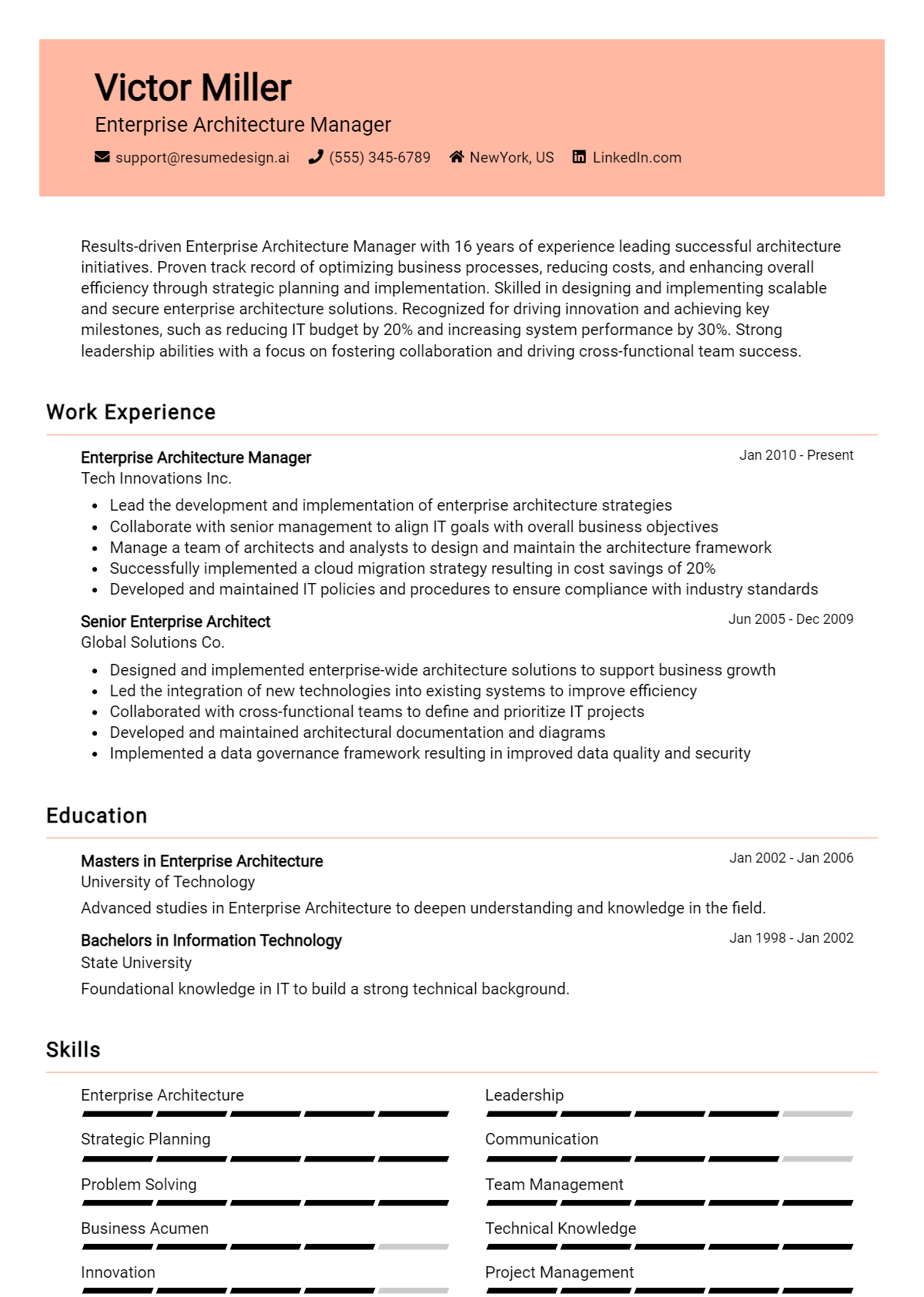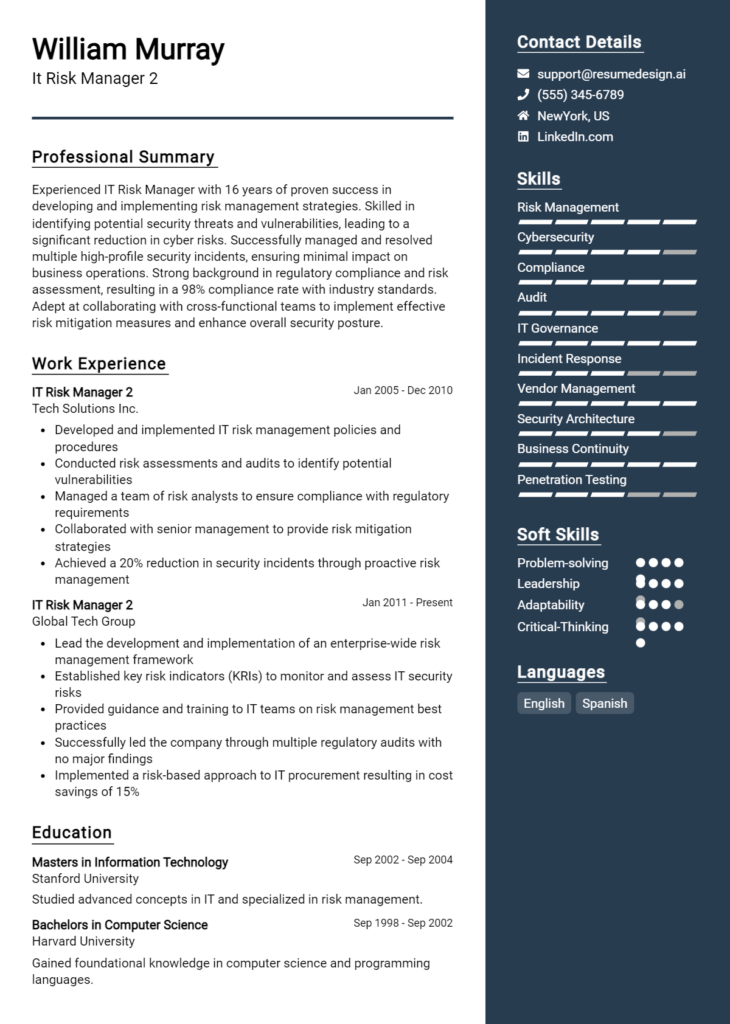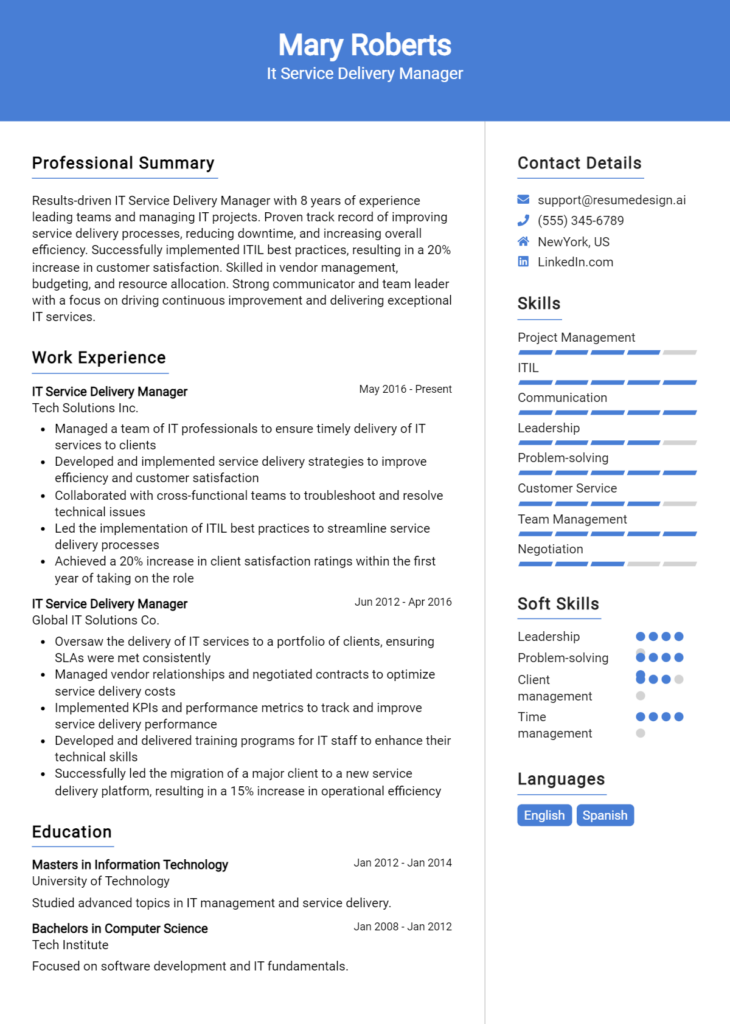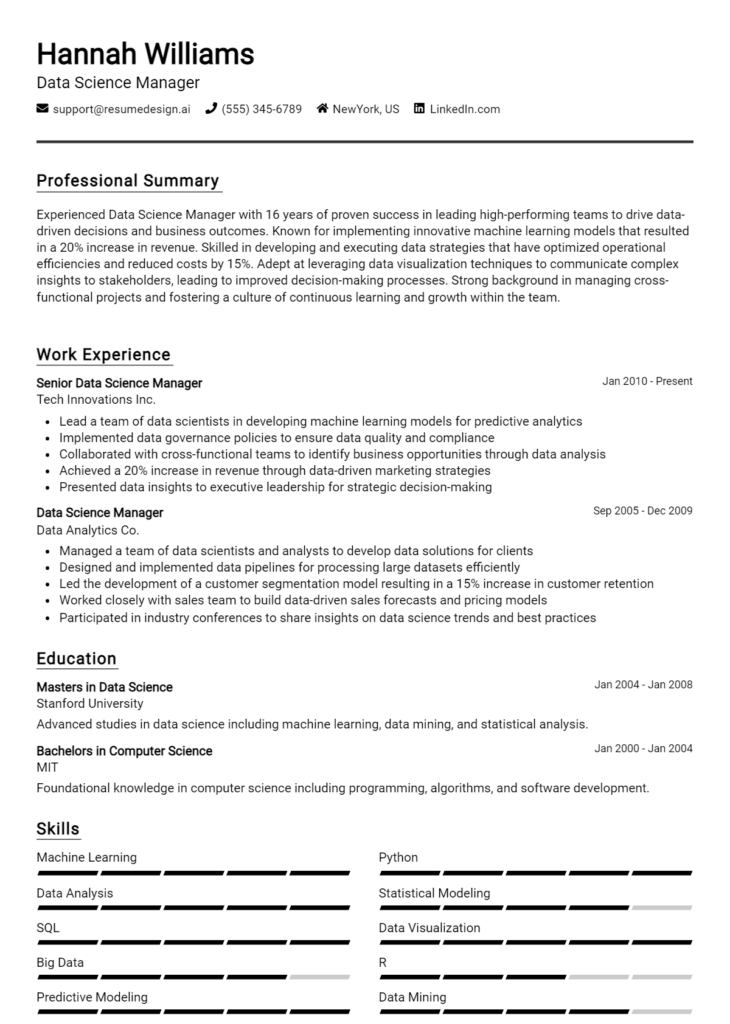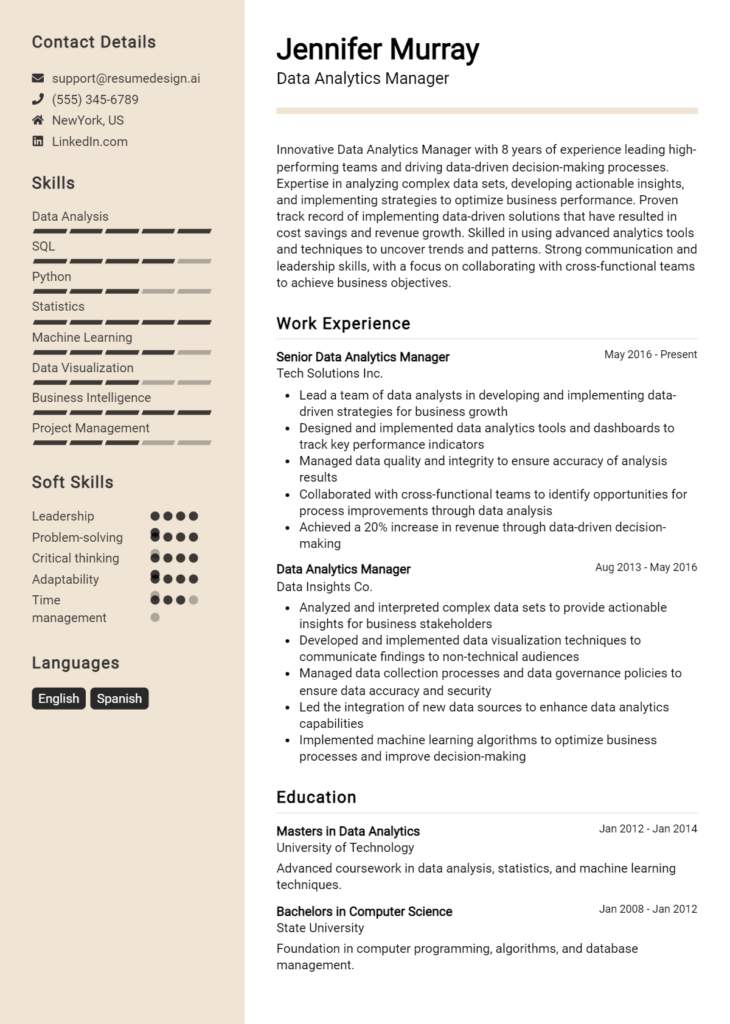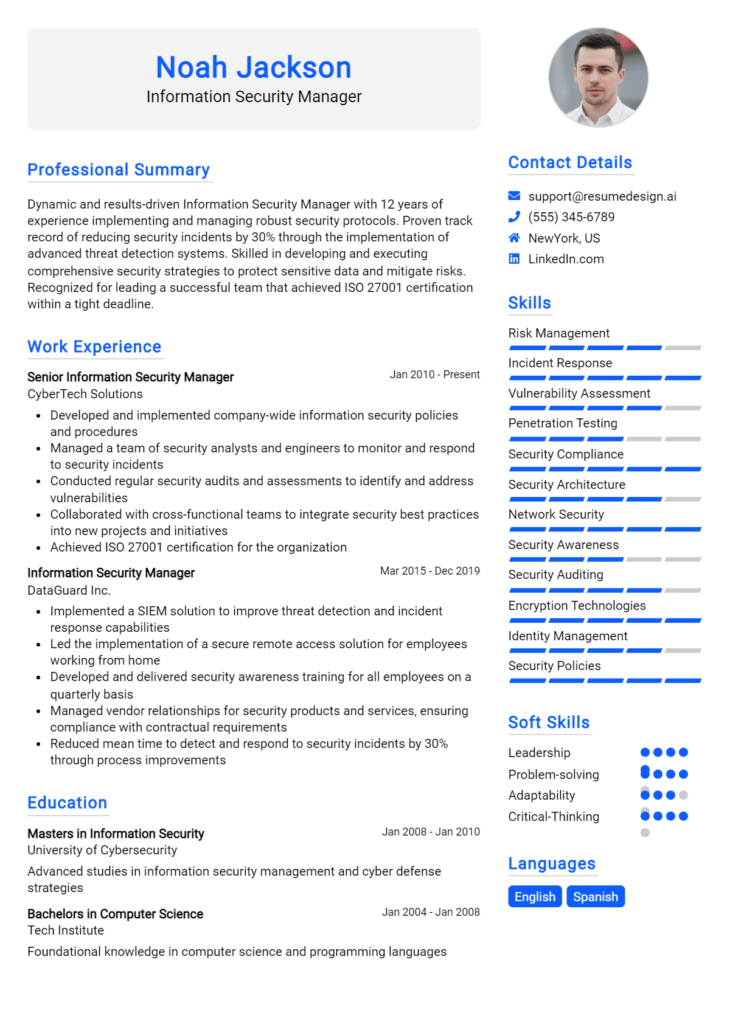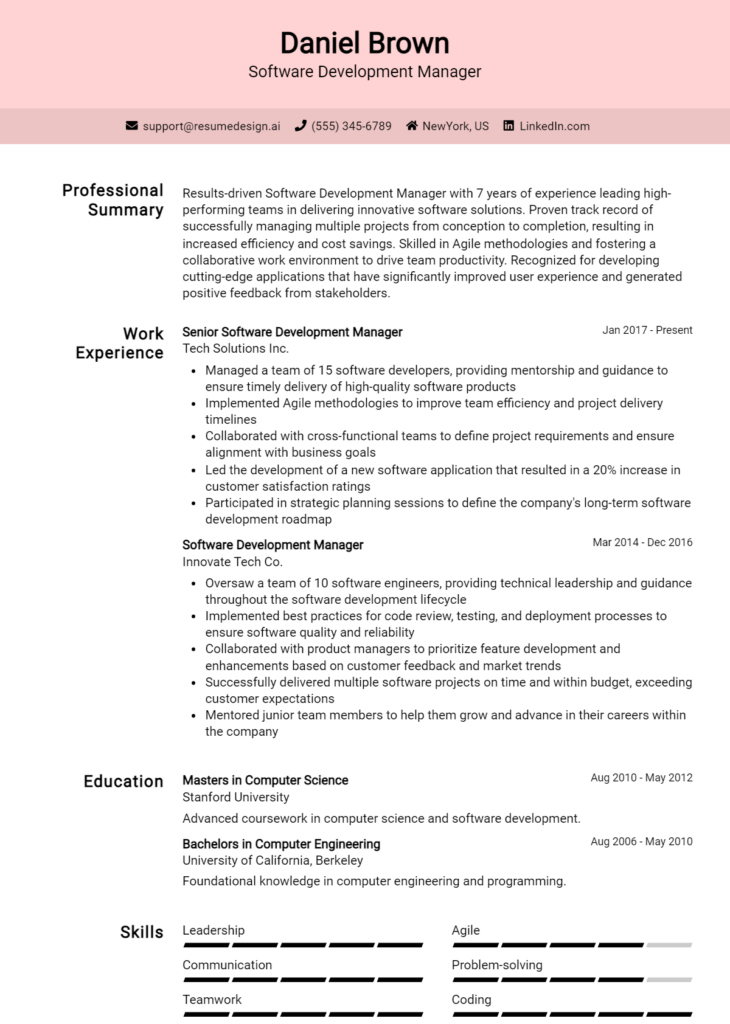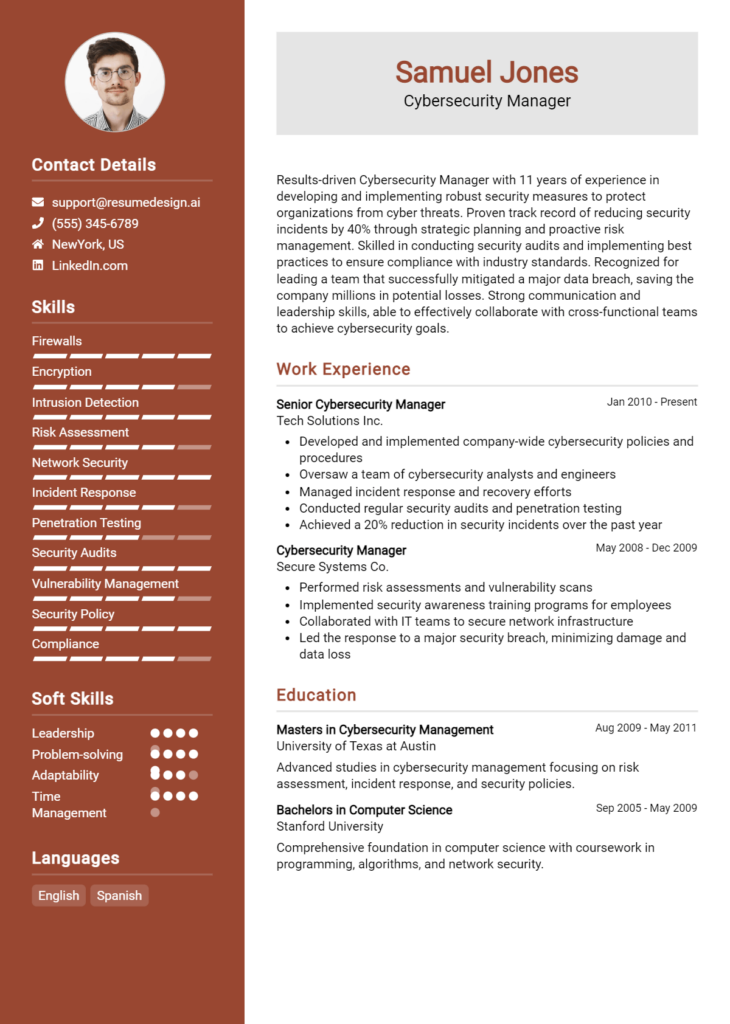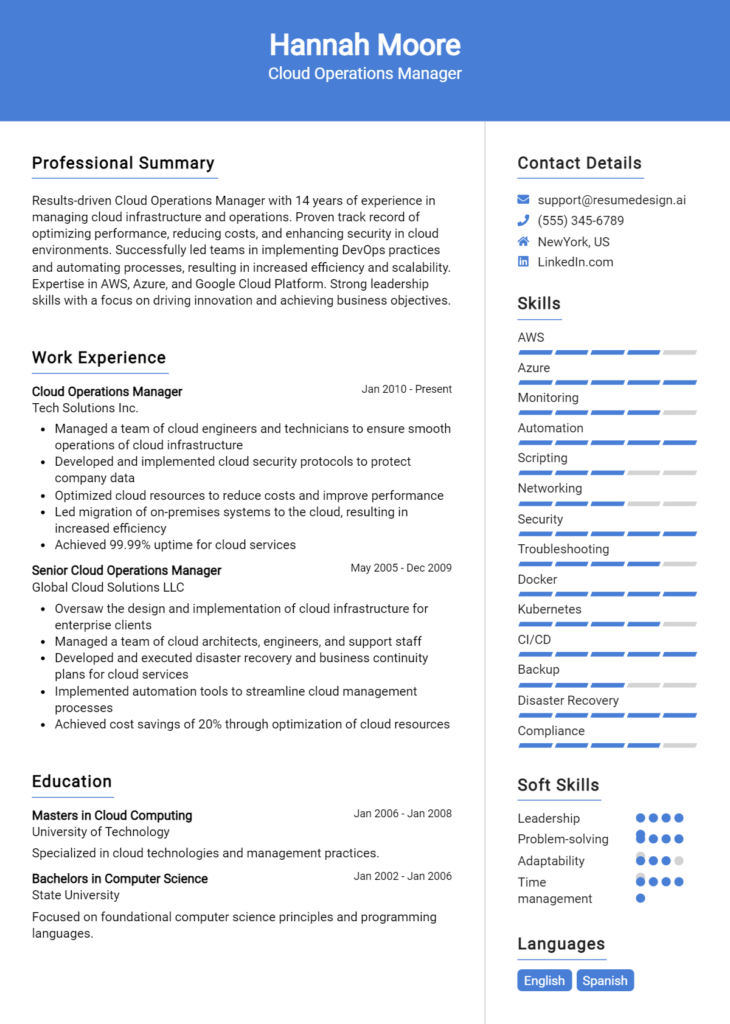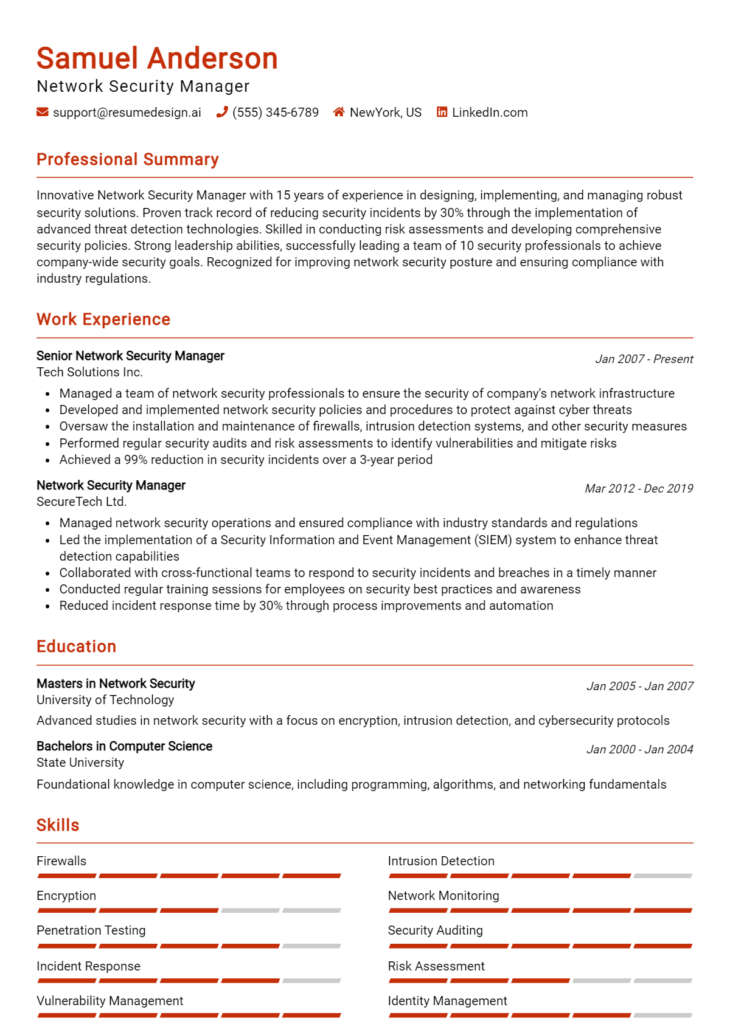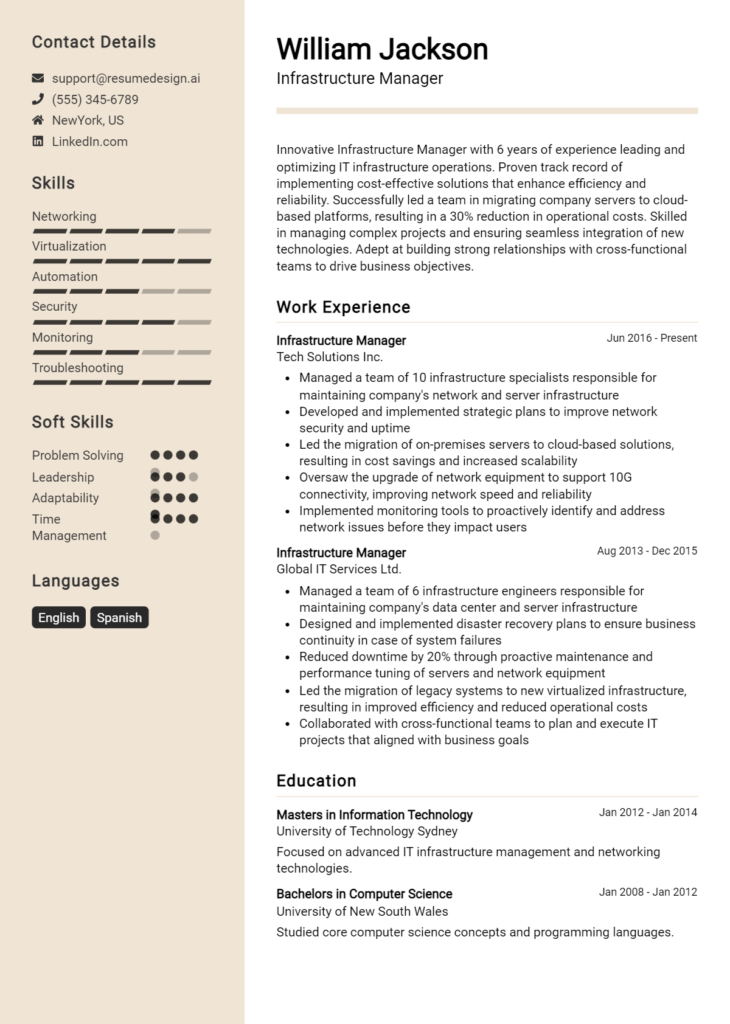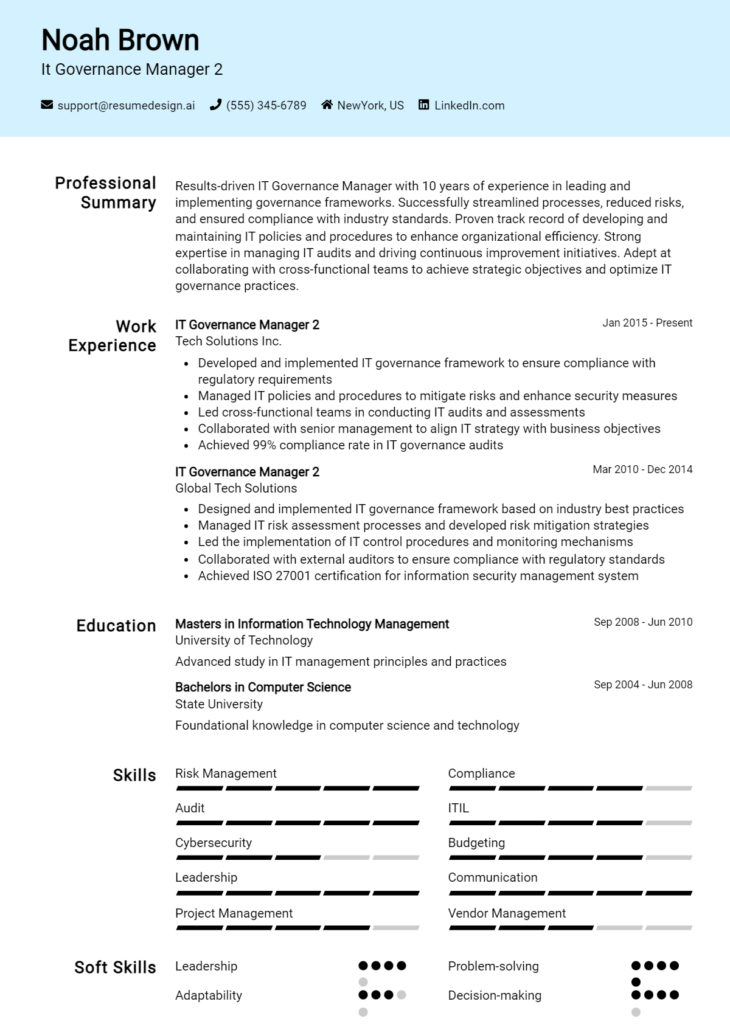Enterprise Architecture Manager Core Responsibilities
An Enterprise Architecture Manager plays a pivotal role in aligning IT strategy with business goals, ensuring seamless collaboration across various departments. Key responsibilities include defining architectural standards, assessing technology trends, and leading cross-functional teams to foster innovation. Essential skills encompass technical expertise, operational insight, and strong problem-solving abilities, all crucial for driving the organization’s objectives. A well-structured resume can effectively highlight these competencies, showcasing the candidate's capacity to enhance organizational performance.
Common Responsibilities Listed on Enterprise Architecture Manager Resume
- Develop and maintain enterprise architecture frameworks and standards.
- Collaborate with business units to align technology initiatives with strategic goals.
- Evaluate and recommend technology solutions to enhance operational efficiency.
- Lead cross-functional teams in the implementation of architectural strategies.
- Ensure compliance with industry regulations and security standards.
- Monitor emerging technology trends and assess their potential impact.
- Facilitate architecture reviews and provide guidance on best practices.
- Manage stakeholder relationships and communicate architectural vision.
- Provide mentorship and support to junior architecture staff.
- Analyze system performance and propose optimizations.
- Document architectural decisions and maintain comprehensive records.
- Conduct risk assessments related to technology investments.
High-Level Resume Tips for Enterprise Architecture Manager Professionals
In today's competitive job market, a well-crafted resume is essential for Enterprise Architecture Manager professionals looking to make a strong first impression on potential employers. Your resume serves as your personal marketing tool, encapsulating your skills, achievements, and value proposition in a succinct format. It is often the first interaction a hiring manager has with you, making it crucial that it reflects not only your technical proficiencies but also your strategic vision and leadership capabilities. This guide will provide practical and actionable resume tips specifically tailored for Enterprise Architecture Manager professionals, ensuring that your application stands out in the crowd.
Top Resume Tips for Enterprise Architecture Manager Professionals
- Tailor your resume to align with the specific job description, using relevant keywords that resonate with the role.
- Highlight your experience in enterprise architecture frameworks such as TOGAF or Zachman to demonstrate your expertise.
- Quantify your achievements; use metrics to showcase how your decisions positively impacted business outcomes.
- Include a summary statement that succinctly captures your career goals and key competencies as an Enterprise Architecture Manager.
- Emphasize your leadership skills and experience in managing cross-functional teams and projects.
- Showcase your ability to bridge the gap between business needs and IT capabilities, highlighting successful transformation initiatives.
- List relevant certifications and training that bolster your qualifications in enterprise architecture.
- Utilize a clean, professional format that allows for easy readability and draws attention to key sections.
- Incorporate industry-specific skills, such as cloud computing, data governance, and security protocols, to enhance your profile.
- Keep your resume concise, ideally no longer than two pages, while ensuring all essential information is included.
By implementing these tips, you can significantly increase your chances of landing a job as an Enterprise Architecture Manager. A well-structured and tailored resume not only highlights your qualifications but also showcases your understanding of the role and the value you can bring to an organization. Take the time to refine your resume, and you will be better positioned to make a lasting impression on potential employers.
Why Resume Headlines & Titles are Important for Enterprise Architecture Manager
In the competitive field of enterprise architecture, a well-crafted resume headline or title serves as a crucial first impression for prospective employers. For an Enterprise Architecture Manager, this headline acts as a succinct summary of qualifications, showcasing expertise and capabilities in a single impactful phrase. A strong headline can capture the attention of hiring managers, making them eager to delve deeper into the resume, as it provides an immediate insight into the candidate's suitability for the role. It should be concise, relevant, and directly aligned with the job being applied for, effectively highlighting the unique value the candidate brings to the table.
Best Practices for Crafting Resume Headlines for Enterprise Architecture Manager
- Keep it concise: Aim for a headline that is one to two lines long.
- Be role-specific: Tailor the headline to reflect the specific position of Enterprise Architecture Manager.
- Highlight key strengths: Use impactful words that showcase your skills, experience, or accomplishments.
- Use industry terminology: Incorporate relevant keywords that resonate with hiring managers in the field.
- Avoid jargon: Ensure that the language is clear and accessible to a broad audience.
- Quantify achievements: Where possible, include metrics or numbers to demonstrate your impact.
- Be authentic: Reflect your true professional identity and career goals in the headline.
- Revise and refine: Don’t hesitate to revisit your headline to enhance its effectiveness.
Example Resume Headlines for Enterprise Architecture Manager
Strong Resume Headlines
"Innovative Enterprise Architecture Manager with 10+ Years Leading Digital Transformation Initiatives"
“Results-Driven Enterprise Architecture Leader Specializing in Cloud Migration and Infrastructure Optimization”
“Strategic Enterprise Architect with Proven Expertise in Aligning IT Strategy with Business Goals”
“Dynamic Enterprise Architecture Manager with a Track Record of Delivering Cost-Effective IT Solutions”
Weak Resume Headlines
“Manager Looking for a Job”
“Experienced Professional in IT”
The strong headlines are effective because they immediately convey the candidate's qualifications and specific areas of expertise relevant to the Enterprise Architecture Manager role. They use impactful language and include quantifiable achievements, making them stand out. In contrast, the weak headlines fail to impress due to their vagueness and lack of specificity, which do not provide hiring managers with any substantial information about the candidate's skills or experience. A compelling headline should invite curiosity and encourage hiring managers to learn more about the candidate's qualifications.
Writing an Exceptional Enterprise Architecture Manager Resume Summary
A well-crafted resume summary is crucial for an Enterprise Architecture Manager, as it serves as the first impression a hiring manager will have of a candidate. A strong summary effectively captures attention by succinctly highlighting key skills, relevant experience, and significant accomplishments that align with the job role. Given the competitive nature of the field, a concise and impactful summary tailored to the specific job application can enhance a candidate's visibility, making it easier for hiring managers to see the value they bring to the organization.
Best Practices for Writing a Enterprise Architecture Manager Resume Summary
- Quantify Achievements: Use numbers and metrics to demonstrate your impact and success in previous roles.
- Focus on Relevant Skills: Highlight the skills that are specifically mentioned in the job description.
- Tailor for Each Job: Customize your summary for the specific position you are applying for to show alignment with the company's needs.
- Be Concise: Aim for 3-5 sentences that encapsulate your professional identity and value proposition.
- Use Strong Action Verbs: Start sentences with dynamic verbs to convey confidence and decisiveness.
- Showcase Industry Knowledge: Mention any relevant frameworks, technologies, or methodologies you are proficient in.
- Highlight Leadership Experience: Emphasize your ability to lead teams, manage projects, and drive strategic initiatives.
- Include Certifications: If applicable, mention any relevant certifications that enhance your qualifications for the role.
Example Enterprise Architecture Manager Resume Summaries
Strong Resume Summaries
Results-driven Enterprise Architecture Manager with over 10 years of experience in aligning IT strategies with business goals. Successfully led a digital transformation project that improved operational efficiency by 30%, resulting in a $2 million cost reduction.
Innovative Enterprise Architect skilled in developing and implementing architecture frameworks that drive business transformation. Proven track record of enhancing system performance by 25% through the integration of cloud solutions in a Fortune 500 company.
Strategic leader in enterprise architecture with expertise in IT governance, risk management, and compliance. Delivered a multi-year architectural roadmap that increased project delivery speed by 40%, enabling the company to exceed revenue targets.
Weak Resume Summaries
Experienced manager looking for new opportunities in enterprise architecture.
Skilled in various technologies and project management practices; I have worked in IT for several years.
The strong resume summaries are considered effective because they provide specific achievements, quantifiable results, and relevant skills that directly relate to the Enterprise Architecture Manager role. In contrast, the weak summaries lack detail, provide no measurable outcomes, and are too generic, failing to convey the candidate's unique qualifications or contributions to potential employers.
Work Experience Section for Enterprise Architecture Manager Resume
The work experience section of an Enterprise Architecture Manager resume is critical as it serves as a testament to the candidate's technical acumen, leadership abilities, and proficiency in delivering high-quality products. This section not only highlights the candidate's expertise in enterprise architecture frameworks, methodologies, and tools, but also illustrates their capacity to lead teams, manage complex projects, and drive organizational success. By quantifying achievements and aligning work experiences with industry standards, candidates can effectively demonstrate their value proposition to potential employers, making it essential to present this information in a clear and compelling manner.
Best Practices for Enterprise Architecture Manager Work Experience
- Highlight relevant technical skills and certifications that align with enterprise architecture frameworks.
- Quantify achievements with specific metrics, such as improved efficiency or cost savings.
- Use action verbs to convey leadership and initiative in project management.
- Include examples of collaboration with cross-functional teams to showcase teamwork and stakeholder engagement.
- Tailor your experience to reflect industry standards and best practices in enterprise architecture.
- Emphasize continuous learning and adaptation to new technologies and methodologies.
- Demonstrate successful implementation of enterprise architecture strategies that contributed to business goals.
- Provide context for each role to illustrate the challenges faced and solutions implemented.
Example Work Experiences for Enterprise Architecture Manager
Strong Experiences
- Led a cross-functional team of 15 in the successful migration of legacy systems to a cloud-based architecture, resulting in a 30% reduction in operational costs.
- Implemented enterprise architecture governance that improved project delivery timelines by 25% while maintaining adherence to compliance standards.
- Designed and executed a comprehensive enterprise data strategy that enhanced data accessibility and analytics capabilities, leading to a 40% increase in business intelligence utilization.
- Collaborated with senior leadership to align IT strategy with business objectives, resulting in a 50% improvement in stakeholder satisfaction ratings.
Weak Experiences
- Worked on various projects related to enterprise architecture.
- Assisted in the migration of systems without specifying the impact or role played.
- Participated in team meetings and discussions about architecture strategies.
- Helped in improving processes but did not quantify results or describe specific contributions.
The examples provided illustrate the distinction between strong and weak experiences in an Enterprise Architecture Manager's resume. Strong experiences are characterized by clear, quantifiable outcomes, specific technical leadership roles, and evidence of collaboration with stakeholders, which collectively convey the candidate's impact and effectiveness. Conversely, weak experiences lack detail and measurable results, making it difficult for potential employers to ascertain the candidate's true capabilities and contributions to previous roles.
Education and Certifications Section for Enterprise Architecture Manager Resume
The education and certifications section of an Enterprise Architecture Manager resume is crucial as it provides insight into the candidate's academic background, relevant certifications, and commitment to continuous learning. This section serves to enhance the candidate's credibility by demonstrating their expertise in enterprise architecture frameworks, methodologies, and industry standards. By including relevant coursework, certifications, and specialized training, candidates can effectively showcase their qualifications and alignment with the job role, making a compelling case to potential employers.
Best Practices for Enterprise Architecture Manager Education and Certifications
- Prioritize relevant degrees in fields such as Computer Science, Information Technology, or Business Administration.
- Include industry-recognized certifications such as TOGAF, Zachman, or Certified Information Systems Architect.
- List specialized training programs or workshops related to enterprise architecture and strategic planning.
- Provide details on relevant coursework that aligns with enterprise architecture principles.
- Highlight any ongoing education, such as webinars or online courses, to demonstrate commitment to staying current in the field.
- Use clear formatting and organization to ensure easy readability of the section.
- Consider including honors or distinctions received during academic pursuits to stand out.
- Be concise yet detailed enough to highlight the depth of knowledge without overwhelming the reader.
Example Education and Certifications for Enterprise Architecture Manager
Strong Examples
- MBA in Information Systems - University of Technology
- TOGAF 9 Certified - The Open Group
- Certified Information Systems Architect (CISA) - ISACA
- Advanced Enterprise Architecture Strategies - Coursera
Weak Examples
- Bachelor's Degree in Philosophy - University of Arts
- Certification in Basic Computer Skills - Online Academy
- High School Diploma - General Studies
- Outdated Certification in Legacy Systems - 2005
The strong examples are considered effective as they directly relate to the qualifications expected of an Enterprise Architecture Manager, showcasing advanced degrees and current, industry-relevant certifications. In contrast, the weak examples lack relevance and do not pertain to the responsibilities or skills needed in enterprise architecture, ultimately failing to contribute to the candidate's credibility in the field.
Top Skills & Keywords for Enterprise Architecture Manager Resume
As an Enterprise Architecture Manager, showcasing the right skills on your resume is crucial for demonstrating your capability to harmonize business strategies with technology solutions. A well-crafted resume that highlights both hard and soft skills not only reflects your technical proficiency but also your ability to lead and collaborate with diverse teams. Employers seek candidates who can navigate complex systems and align IT infrastructure with organizational goals. By emphasizing your skills effectively, you position yourself as a valuable asset capable of driving innovation and efficiency within the enterprise.
Top Hard & Soft Skills for Enterprise Architecture Manager
Hard Skills
- Enterprise Architecture Frameworks (e.g., TOGAF, Zachman)
- Cloud Computing Solutions (AWS, Azure, Google Cloud)
- IT Strategy Development
- Business Process Modeling
- Data Management and Governance
- Systems Integration
- Application Development and Management
- Security Architecture
- IT Infrastructure Management
- Software Development Life Cycle (SDLC)
- Enterprise Resource Planning (ERP) Systems
- IT Compliance and Risk Management
- Network Architecture and Design
- Microservices Architecture
- Digital Transformation Strategies
Soft Skills
- Leadership and Team Management
- Strategic Thinking
- Problem Solving
- Communication and Interpersonal Skills
- Adaptability and Flexibility
- Stakeholder Engagement
- Analytical Thinking
- Conflict Resolution
- Time Management
- Decision Making
- Negotiation Skills
- Empathy and Emotional Intelligence
- Change Management
- Influencing and Persuasion
- Creativity and Innovation
By focusing on these skills alongside relevant work experience, you can craft a compelling resume that captures the attention of hiring managers and highlights your qualifications as an Enterprise Architecture Manager.
Stand Out with a Winning Enterprise Architecture Manager Cover Letter
I am excited to apply for the Enterprise Architecture Manager position at [Company Name], as advertised on [where you found the job listing]. With over [X years] of experience in enterprise architecture and a proven track record of aligning technology initiatives with business goals, I am confident in my ability to drive digital transformation and enhance operational efficiency. My expertise in both strategic planning and technical implementation allows me to bridge the gap between IT and business, ensuring that our architectural framework supports the overall objectives of the organization.
In my previous role at [Previous Company Name], I successfully led a team of architects in developing and implementing a comprehensive enterprise architecture strategy that improved system interoperability and reduced operational costs by [X%]. By fostering collaboration across departments and utilizing industry best practices, we were able to streamline processes and deliver solutions that exceeded stakeholder expectations. My hands-on experience with cloud technologies, microservices, and data management strategies has equipped me with the necessary tools to lead your team in navigating the complexities of modern enterprise architecture.
I am particularly drawn to [Company Name] because of its commitment to innovation and excellence. I admire your initiatives in [mention any specific initiative or project from the company that you appreciate], and I am eager to contribute my skills in developing robust architectural frameworks that not only enhance existing systems but also support future growth. I believe that my analytical mindset, combined with my passion for emerging technologies, will enable me to add significant value to your organization and help drive successful outcomes.
Thank you for considering my application. I look forward to the opportunity to discuss how my experience and vision align with the goals of [Company Name]. I am excited about the possibility of contributing to your team and helping to shape the future of enterprise architecture within your organization.
Common Mistakes to Avoid in a Enterprise Architecture Manager Resume
When crafting a resume for the role of an Enterprise Architecture Manager, it's crucial to present a clear and compelling narrative of your qualifications and experiences. However, many candidates make common mistakes that can detract from their overall effectiveness. Avoiding these pitfalls can significantly enhance your chances of standing out to hiring managers. Here are some of the most prevalent mistakes to look out for:
Vague Job Descriptions: Failing to provide specific details about your previous roles can leave hiring managers uncertain about your actual contributions and skills. Use quantifiable achievements to illustrate your impact.
Ignoring Relevant Skills: Omitting technical skills or frameworks relevant to enterprise architecture, such as TOGAF, Zachman, or ArchiMate, can lead to a lack of alignment with the job description and requirements.
Overloading with Jargon: While industry-specific terminology is important, excessive jargon can make your resume difficult to read. Strive for clarity and ensure that your skills and experiences are easily understood.
Neglecting Soft Skills: Enterprise Architecture Managers not only need technical expertise but also strong interpersonal skills. Failing to highlight attributes like leadership, communication, and collaboration can undermine your candidacy.
Using a Generic Resume: One-size-fits-all resumes often lack the customization needed to catch a recruiter’s eye. Tailor your resume for each position by incorporating specific keywords and aligning your experiences with the job description.
Inconsistent Formatting: A cluttered or inconsistent resume layout can distract from your content. Maintain uniform formatting in terms of font, size, and spacing to ensure readability and professionalism.
Not Showcasing Continuous Learning: Given the rapid evolution of technology, not mentioning ongoing education, certifications, or training can make you seem stagnant. Highlighting your commitment to professional development is crucial.
Failing to Include Results: Simply listing duties without showcasing outcomes can diminish the impact of your experiences. Use metrics and specific examples to demonstrate how you added value in your previous roles.
Conclusion
As we've explored the essential responsibilities and skills of an Enterprise Architecture Manager, it's clear that this role is pivotal in aligning business strategies with technology solutions. Key competencies include strategic thinking, excellent communication skills, and a deep understanding of IT infrastructure and enterprise systems. Additionally, the ability to manage teams and drive change is crucial for success in this position.
In light of this, it's vital to ensure that your resume reflects these competencies and stands out to potential employers. A polished resume can make a significant difference in your job search. We encourage you to take a moment to review and enhance your Enterprise Architecture Manager resume.
To streamline this process, consider utilizing available resources such as resume templates, which can provide a professional layout, and the resume builder for easy editing. You can also check out resume examples for inspiration on how to effectively present your experience and skills. Don’t forget about the importance of a strong introduction; our cover letter templates can help you create a compelling narrative that complements your resume.
Take action now and equip yourself with the tools needed to advance your career in enterprise architecture!

